Sanitary Sewer Overflow Discharges: Estimation Based on Flow Rate Measurement in Pumping Mains
Abstract
1. Introduction
2. Materials and Methods
2.1. Modeling Methodology for Estimating SSO Discharges
- (a)
- Ensuring that the modeled and measured volumes are similar;
- (b)
2.2. Hydrological Models Used
- (a)
- The time–area curve, which is considered linear, meaning that the only calibration parameter is the translation time interval (t). For the linear time–area relationship, the instantaneous unit hydrograph is rectangular, with a duration equal to the catchment concentration time (tc) and ordinate equal to 1/tc expressed in terms of the unit precipitation per unit of time (e.g., mm/h).
- (b)
- The linear reservoir model, whose only calibration parameter is the attenuation coefficient of the hydrograph as it passes through the reservoir (K).where I(t) is the rainfall volume per unit time over the catchment at time t (e.g., mm/h), and O(t) is the runoff rate downstream of the catchment at time t (mm/h). In the form of finite differences and solving in order to O(t + dt), this yieldswith and .
- (c)
- The Clark model, which considers the routing of the time–area hydrograph through a linear reservoir to provide diffusion, requiring two calibration coefficients if the linear time–area relationship is used (t; K). Trying to maintain a single calibration parameter in the Clark model, a sensitivity analysis was carried out considering one of the coefficients as half, equal to, or double the other. As the best results were obtained by keeping the two coefficients equal (t = K), the parameterization of the model continued with this rule, with good results always being obtained, as will be seen below.
- (d)
- The simplified SWMM model, considering a single 100% impermeable catchment with a square shape, fixed Manning coefficient (0.05 s.m−1/3), and zero hydrological losses, in which the catchment slope (i) is the only calibration parameter.In the context of this work, SWMM was used to simulate the hydrodynamics in the sewer networks using the full Saint-Venant equations for both cases described in the next sections: the Albufeira interceptor system and the hypothetical case to validate the methodology.SWMM allows for a very detailed description of catchments, including their hydrological losses, low-impact development features, and the kinematic equation for flow convolution. However, the estimation of the stormwater inflows to each of the pumping stations was carried out herein in a simplified and conceptual way, as described above (Figure 2b).
2.3. The Albufeira Case Study
2.4. Hypothetical Case to Validate the Methodology and Sensitivity Analysis of the Parameters
- (a)
- Calibration using the flow rates measured upstream of the PS to evaluate the behavior of the hydrological model.
- (b)
- Calibration using the flow rates measured downstream of the PS and treated as indicated in the first task of the methodology described in Section 3.1; in this case, the errors in the results caused by discontinuous measurement at the pumping main are added to the errors of the hydrological model studied in the previous paragraph. We sought to create a significantly more conservative scenario than that of practically all PSs in Albufeira, which was possibly close to the case of Fer2 PS; in the example of Figure 4, pump stop and start cycles lead to constant flow rate values for more than 60 min during dry weather and 30 min during heavy precipitation peaks.
3. Results and Discussion
3.1. Hypothetical Case to Assess the Methodology
3.1.1. Models Calibrated against the Flow Rates Measured Upstream of the PS at the L0 Sewer
3.1.2. Models Calibrated against the Flow Rates Measured at the Pumping Main
3.1.3. Model Verification
3.2. Albufeira Case Study
3.2.1. Vale1 Pumping Station
3.2.2. Fer2 Pumping Station
| Model | MaxQPS (L/s) | Area (ha) | Model Coefficient | Σ(E2) 1 (m6) | Pumped Stormw. (m3) | SSO Vol. (m3) |
|---|---|---|---|---|---|---|
| Time–area curve | 17.6 | 2.642 | t = 187 min. | 118,450 | 1221 | 385 |
| Linear reservoir | 17.6 | 2.442 | K = 97 min. | 105,559 | 1221 | 261 |
| Clark | 17.6 | 2.687 | t = K = 60 min. | 112,744 | 1221 | 412 |
| Simplified SWMM | 17.6 | 2.500 | i = 2.010% | 119,826 | 1221 | 294 |
4. Conclusions
- Clark’s model provided the best results, which can be classified as good for most cases and quite satisfactory for others.
- For all cases studied, good results were obtained from the Clark model considering a routing coefficient equal to the storage coefficient.
- The time–area curve model tends to overestimate SSO discharges.
- The linear reservoir consistently underestimates SSO discharges.
- The simplified SWMM model generally provides acceptable estimates of SSO discharges, although the determinism in weir crest height and the potential storage in the sewer network are sources of uncertainty and error.
Author Contributions
Funding
Data Availability Statement
Conflicts of Interest
References
- Johnson, C.F. Equipment, Methods, and Results from Washington, D.C., Combined Sewer Overflow Studies. J. Water Pollut. Control Fed. 1961, 33, 721–733. Available online: https://www.jstor.org/stable/25034443 (accessed on 10 May 2024).
- David, L.M.; Matos, R.S. Wet weather water quality modelling of a Portuguese urban catchment: Difficulties and benefits. Water Sci. Technol. 2002, 45, 131–140. [Google Scholar] [CrossRef] [PubMed]
- Quaranta, E.; Fuchs, S.; Liefting, H.J.; Schellart, A.; Pistocchi, A. A hydrological model to estimate pollution from combined sewer overflows at the regional scale: Application to Europe. J. Hydrol. Reg. Stud. 2022, 41, 101080. [Google Scholar] [CrossRef]
- Giakoumis, T.; Voulvoulis, N. Combined sewer overflows: Relating event duration monitoring data to wastewater systems’ capacity in England. Environ. Sci. Water Res. Technol. 2023, 9, 707–722. [Google Scholar] [CrossRef]
- Farina, A.; Gargano, R.; Greco, R. Effects of urban catchment characteristics on combined sewer overflows. Environ. Res. 2024, 244, 117945. [Google Scholar] [CrossRef] [PubMed]
- Montserrat, A.; Bosch, L.; Kiser, M.A.; Poch, M.; Corominas, L. Using data from monitoring combined sewer overflows to assess, improve, and maintain combined sewer systems. Sci. Total Environ. 2015, 505, 1053–1061. [Google Scholar] [CrossRef] [PubMed]
- Spill, C.; Ditzel, L.; Gassmann, M. Small villages and their sanitary infrastructure—An unnoticed influence on water quantity and a threat to water quality in headwater catchments. Environ. Monit. Assess. 2023, 195, 1482. [Google Scholar] [CrossRef] [PubMed]
- Nasrin, T.; Sharma, A.K.; Muttil, N. Impact of Short Duration Intense Rainfall Events on Sanitary Sewer Network Performance. Water 2017, 9, 225. [Google Scholar] [CrossRef]
- Chen, S.; Qin, H.; Zheng, Y.; Fu, G. Spatial variations of pollutants from sewer interception system overflow. J. Environ. Manag. 2019, 233, 748–756. [Google Scholar] [CrossRef]
- Muttil, N.; Nasrin, T.; Sharma, A.K. Impacts of extreme rainfalls on sewer overflows and WSUD–based mitigation strategies: A review. Water 2023, 15, 429. [Google Scholar] [CrossRef]
- Perez, G.; Gomez-Velez, J.D.; Grant, S.B. The sanitary sewer unit hydrograph model: A comprehensive tool for wastewater flow modeling and inflow-infiltration simulations. Water Res. 2024, 249, 120997. [Google Scholar] [CrossRef]
- Montoya-Coronado, V.A.; Tedoldi, D.; Castebrunet, H.; Molle, P.; Lipeme Kouyi, G. Data-driven methodological approach for modeling rainfall-induced infiltration effects on combined sewer overflow in urban catchments. J. Hydrol. 2024, 632, 130834. [Google Scholar] [CrossRef]
- European Commission. Proposal for a Directive of the European Parliament and of the Council Concerning Urban Wastewater Treatment (Recast). Available online: https://eur-lex.europa.eu/legal-content/EN/TXT/?uri=CELEX%3A52022PC0541&qid=1715593129776 (accessed on 10 May 2024).
- Council of the European Union. Proposal for a Directive of the European Parliament and of the Council Concerning Urban Wastewater Treatment (Recast). Final Compromise Text Endorsed at the Permanent Representatives Committee Meeting of 1 March 2024. Brussels, 1 March 2024. Available online: https://data.consilium.europa.eu/doc/document/ST-7108-2024-INIT/en/pdf (accessed on 10 May 2024).
- Sanitary Sewer Overflows (SSOs). Available online: https://www.epa.gov/npdes/sanitary-sewer-overflows-ssos (accessed on 10 May 2024).
- US EPA. Chapter 5—CSS Monitoring. In Guidance for Monitoring and Modeling, EPA 832-B-99-002; US EPA Office of Water: Washington, DC, USA, 1999; p. 37. Available online: https://www3.epa.gov/npdes/pubs/sewer.pdf (accessed on 10 May 2024).
- Jeanbourquin, D.; Sage, D.; Nguyen, L.; Schaeli, B.; Kayal, S.; Barry, D.A.; Rossi, L. Flow measurements in sewers based on image analysis: Automatic flow velocity algorithm. Water Sci. Technol. 2011, 64, 1108–1114. [Google Scholar] [CrossRef]
- Ahm, M.; Thorndahl, S.; Nielsen, J.E.; Rasmussen, M.R. Estimation of Combined Sewer Overflow Discharge: A Software Sensor Approach Based on Local Water Level Measurements. Water Sci. Technol. 2016, 74, 2683–2696. [Google Scholar] [CrossRef] [PubMed]
- Ji, H.W.; Yoo, S.S.; Lee, B.-J.; Koo, D.D.; Kang, J.-H. Measurement of Wastewater Discharge in Sewer Pipes Using Image Analysis. Water 2020, 12, 1771. [Google Scholar] [CrossRef]
- Bertrand-Krajewski, J.-L.; Clemens-Meyer, F.; Lepot, M. (Eds.) Metrology in Urban Drainage and Stormwater Management: Plug and Pray; IWA Publishing: London, UK, 2021; ISBN 978-1-78906-011-9. [Google Scholar]
- Fencl, M.; Grum, M.; Borup, M.; Mikkelsen, P.S. Robust model for estimating pumping station characteristics and sewer flows from standard pumping station data. Water Sci. Technol. 2019, 79, 1739–1745. [Google Scholar] [CrossRef]
- Van Assel, J.; Kroll, S.; Delgado, R. Calculation of Dry Weather Flows in Pumping Stations to Identify Inflow and Infiltration in Urban Drainage Systems. Water 2023, 15, 864. [Google Scholar] [CrossRef]
- Deletic, A.; Dotto, C.B.S.; McCarthy, D.T.; Kleidorfer, M.; Freni, G.; Mannina, G.; Uhl, M.; Henrichs, M.; Fletcher, T.D.; Rauch, W.; et al. Assessing Uncertainties in Urban Drainage Models. Phys. Chem. Earth Parts A/B/C 2012, 42–44, 3–10. [Google Scholar] [CrossRef]
- Moges, E.; Demissie, Y.; Larsen, L.; Yassin, F. Review: Sources of Hydrological Model Uncertainties and Advances in Their Analysis. Water 2021, 13, 28. [Google Scholar] [CrossRef]
- Sriwastava, A.K.; Tait, S.; Schellart, A.; Kroll, S.; Dorpe, M.V.; Assel, J.V.; Shucksmith, J. Quantifying Uncertainty in Simulation of Sewer Overflow Volume. J. Environ. Eng. 2018, 144, 04018050. [Google Scholar] [CrossRef]
- Van Der Werf, J.A.; Kapelan, Z.; Langeveld, J. Real-time control of combined sewer systems: Risks associated with uncertainties. J. Hydrol. 2023, 617, 128900. [Google Scholar] [CrossRef]
- Vallabhaneni, S.; Burgess, E.H.; Burgess, E.H. Computer Tools for Sanitary Sewer System Capacity Analysis and Planning; EPA/600/R-07/111; U.S. Environmental Protection Agency: Washington, DC, USA, 2007. [Google Scholar]
- Rossman, L.A. Storm Water Management Model User’s Manual Version 5.1; U.S. Environmental Protection Agency: Washington, DC, USA, 2015. [Google Scholar]
- Karpf, C.; Krebs, P. Quantification of groundwater infiltration and surface water inflows in urban sewer networks based on a multiple model approach. Water Res. 2011, 45, 3129–3136. [Google Scholar] [CrossRef] [PubMed]
- Bonneau, J.; Fletcher, T.D.; Costelloe, J.F.; Burns, M.J. Stormwater infiltration and the ‘urban karst’—A review. J. Hydrol. 2017, 552, 141–150. [Google Scholar] [CrossRef]
- Choat, B.E.; Bhaskar, A.S. Spatial Arrangement of Stormwater Infiltration Affects Subsurface Storage and Baseflow. J. Hydrol. Eng. 2020, 25, 04020048. [Google Scholar] [CrossRef]
- Bell, C.D.; Wolfand, J.M.; Panos, C.L.; Bhaskar, A.S.; Gilliom, R.L.; Hogue, T.S.; Hopkins, K.G.; Jefferson, A.J. Stormwater control impacts on runoff volume and peak flow: A meta-analysis of watershed modelling studies. Hydrol. Process. 2020, 34, 3134–3152. [Google Scholar] [CrossRef]
- Zhang, K.; Parolari, A.J. Impact of stormwater infiltration on rainfall-derived inflow and infiltration: A physically based surface–subsurface urban hydrologic model. J. Hydrol. 2022, 610, 127938. [Google Scholar] [CrossRef]
- Sebo, S.; McDonald, W. Influence of sewershed characteristics on rainfall-derived inflow and infiltration. J. Am. Water Resour. Assoc. 2022, 58, 1483–1496. [Google Scholar] [CrossRef]
- Nash, J.E.; Sutcliffe, J.V. River flow forecasting through conceptual models: Part 1. A discussion of principles. J. Hydrol. 1970, 10, 282–290. [Google Scholar] [CrossRef]
- Gupta, H.V.; Kling, H.; Yilmaz, K.K.; Martinez, G.F. Decomposition of the mean squared error and NSE performance criteria: Implications for improving hydrological modelling. J. Hydrol. 2009, 377, 80–91. [Google Scholar] [CrossRef]
- Moriasi, D.N.; Gitau, M.W.; Pai, N.; Daggupati, P. Hydrologic and Water Quality Models: Performance Measures and Evaluation Criteria. Trans. ASABE 2015, 58, 1763–1785. [Google Scholar]
- David, L.M.; Mota, T.M. Quality Assessment of Small Urban Catchments Stormwater Models: A New Approach Using Old Metrics. Hydrology 2022, 9, 87. [Google Scholar] [CrossRef]
- An, W.W.; Gianvito, J.M. Kiski Valley WPCA Combined Sewer System Long Term Model Study. J. Water Manag. Model. 2011, 19, R241-17. [Google Scholar] [CrossRef]
- Peche, A.; Graf, T.; Fuchs, L.; Neuweiler, I. Physically based modeling of stormwater pipe leakage in an urban catchment. J. Hydrol. 2019, 573, 778–793. [Google Scholar] [CrossRef]
- Choi, N.; Schmidt, A.R. Rainfall-Derived Infiltration and Inflow Estimate in a Sanitary Sewer System Using Three Impulse Response Functions Derived from Physics-Based Models. Water Resour. Manag. 2023, 37, 305–319. [Google Scholar] [CrossRef]
- David, L.M.; Matos, J.S. Wet-weather urban discharges: Implications from adopting the revised European Directive concerning the quality of bathing water. Water Sci. Technol. 2005, 52, 9–17. [Google Scholar] [CrossRef] [PubMed]
- David, L.M.; Matos, J.S. Combined sewer overflow emissions to bathing waters in Portugal. How to reduce in densely urbanized areas? Water Sci. Technol. 2005, 52, 183–190. [Google Scholar] [CrossRef] [PubMed]
- Borah, D.K. Hydrologic procedures of storm event watershed models: A comprehensive review and comparison. Hydrol. Process. 2011, 25, 3472–3489. [Google Scholar] [CrossRef]
- Beven, K.J. A history of the concept of time of concentration. Hydrol. Earth Syst. Sci. 2020, 24, 2655–2670. [Google Scholar] [CrossRef]
- Jun, C.H.; Yoo, C.L. Relative roles of time-area curve and storage coefficient on the shape of Clark’s instantaneous unit hydrograph: Analytical approach. J. Hydrol. Eng. 2021, 26, 06021001. [Google Scholar] [CrossRef]
- Siemens; LNEC; IST; UAlg; AdA. SINERGEA—Intelligent System to Support the Efficient Use of Resources and the Inundation and Coastal Contamination Emergency Management in Coastal Cities; Final Technical-Scientific Report; Confidential Funding Compliance Evaluation Report; Siemens, S.A.: Amadora, Portugal, 2023; p. 88. (In Portuguese) [Google Scholar]
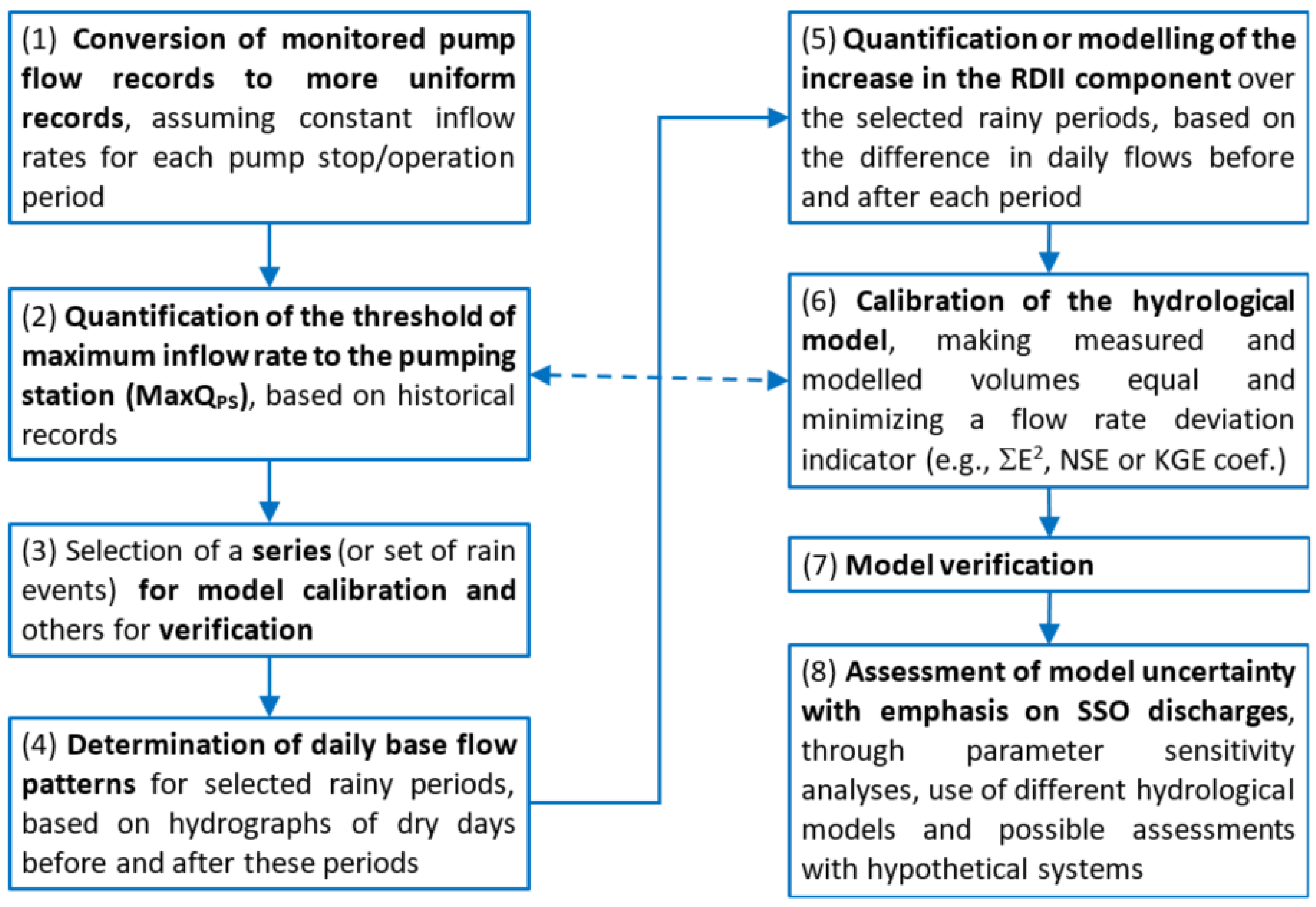

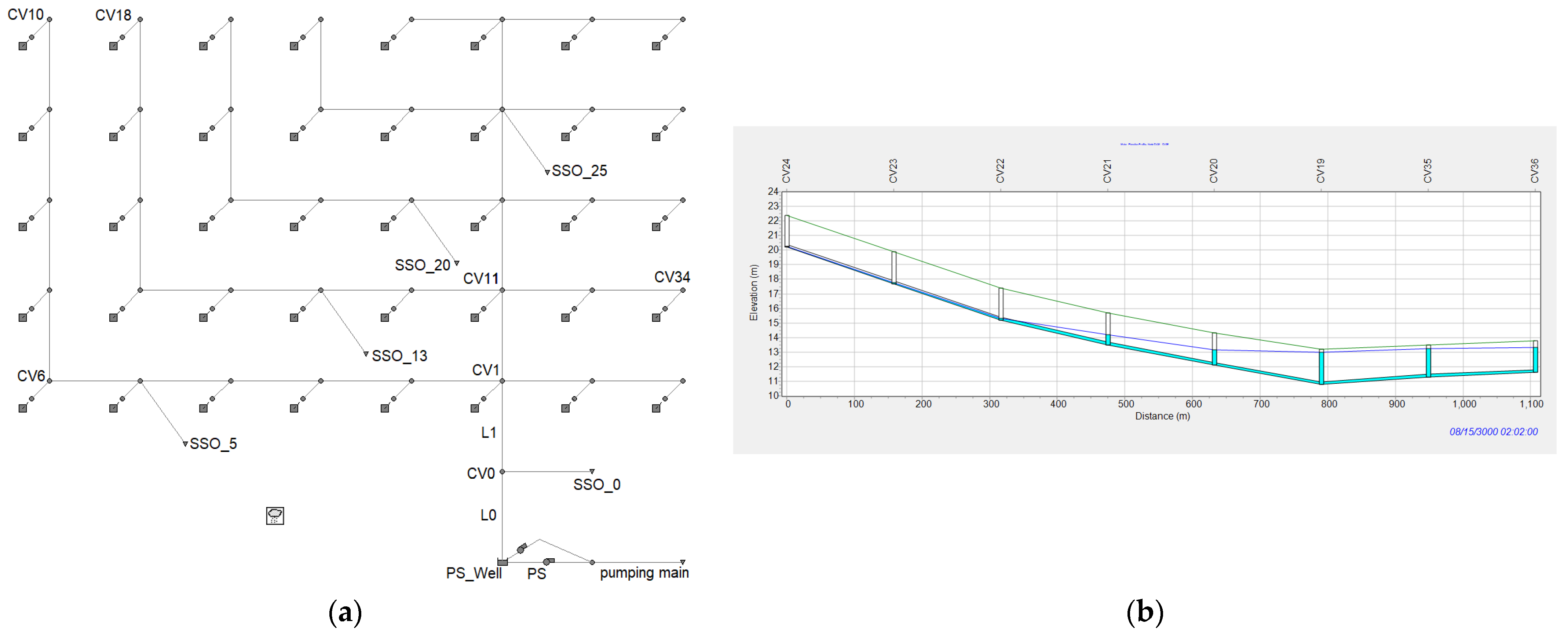
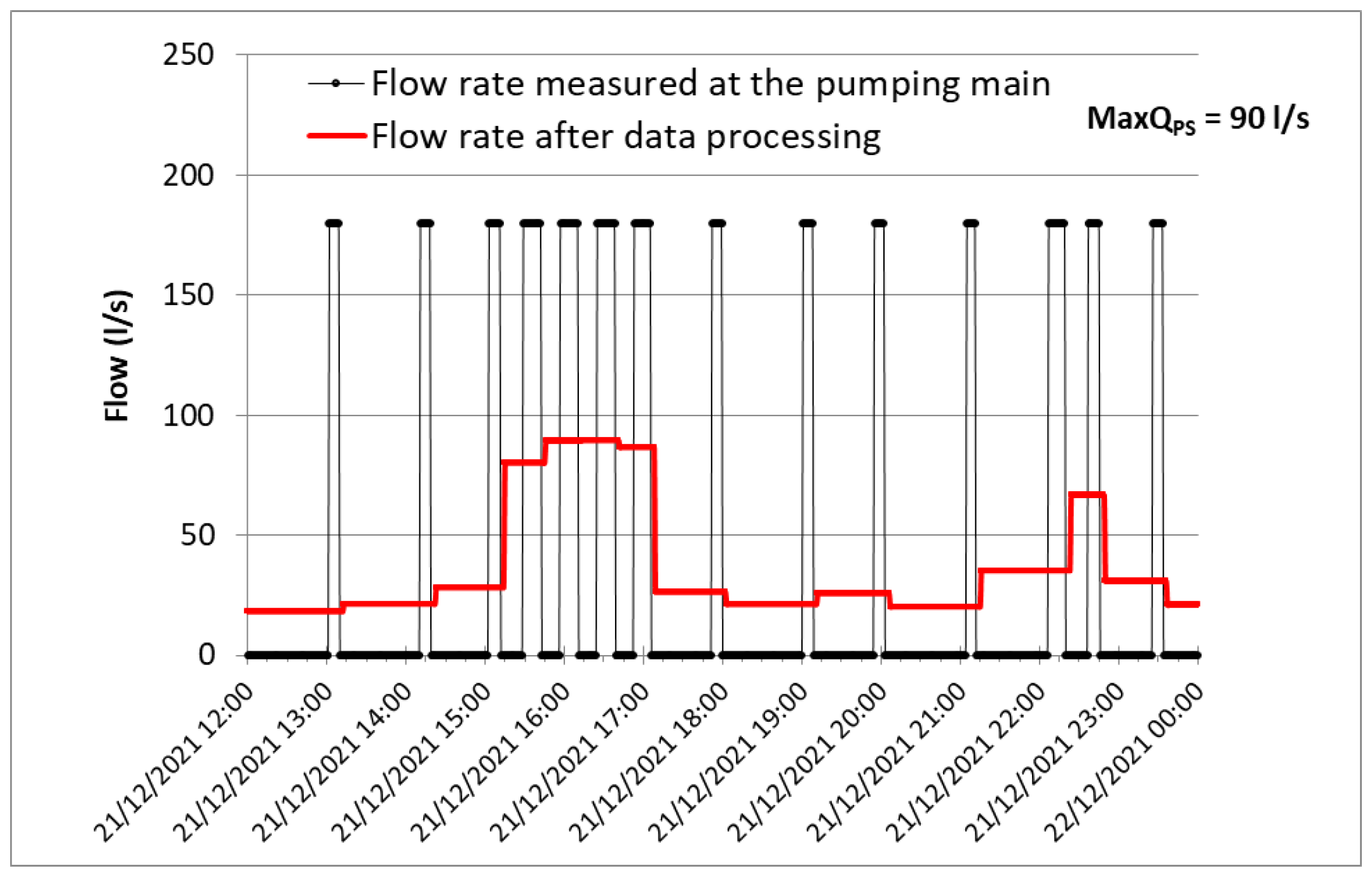
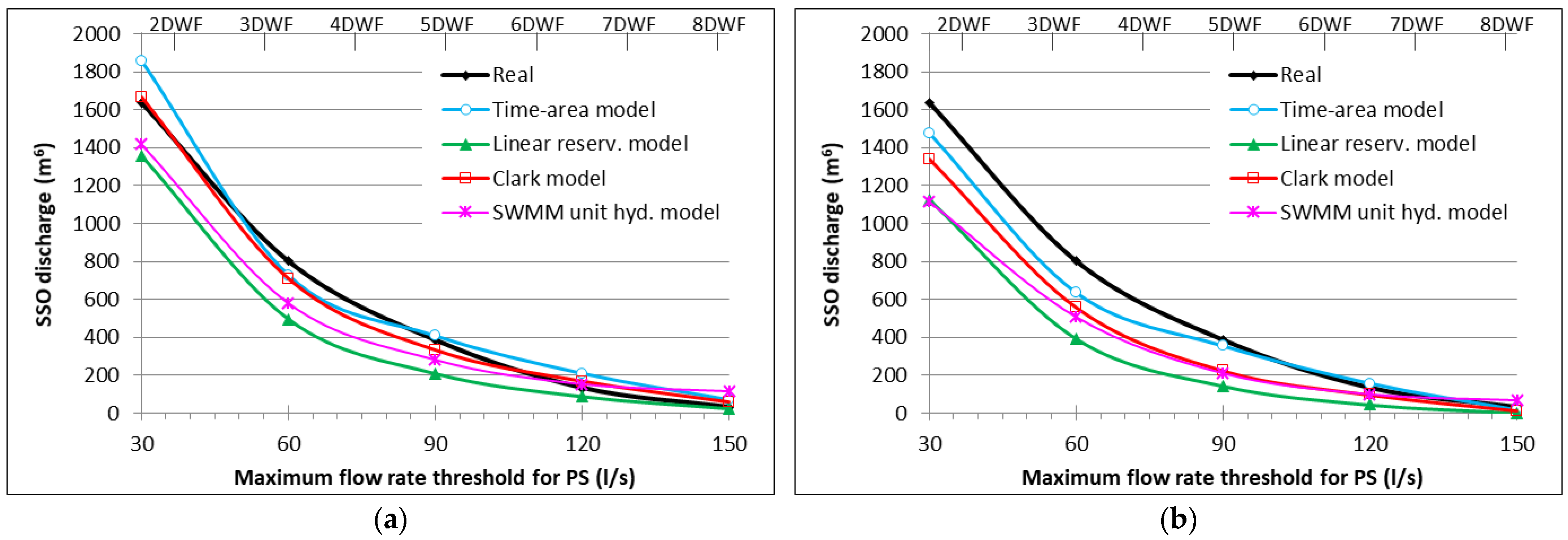
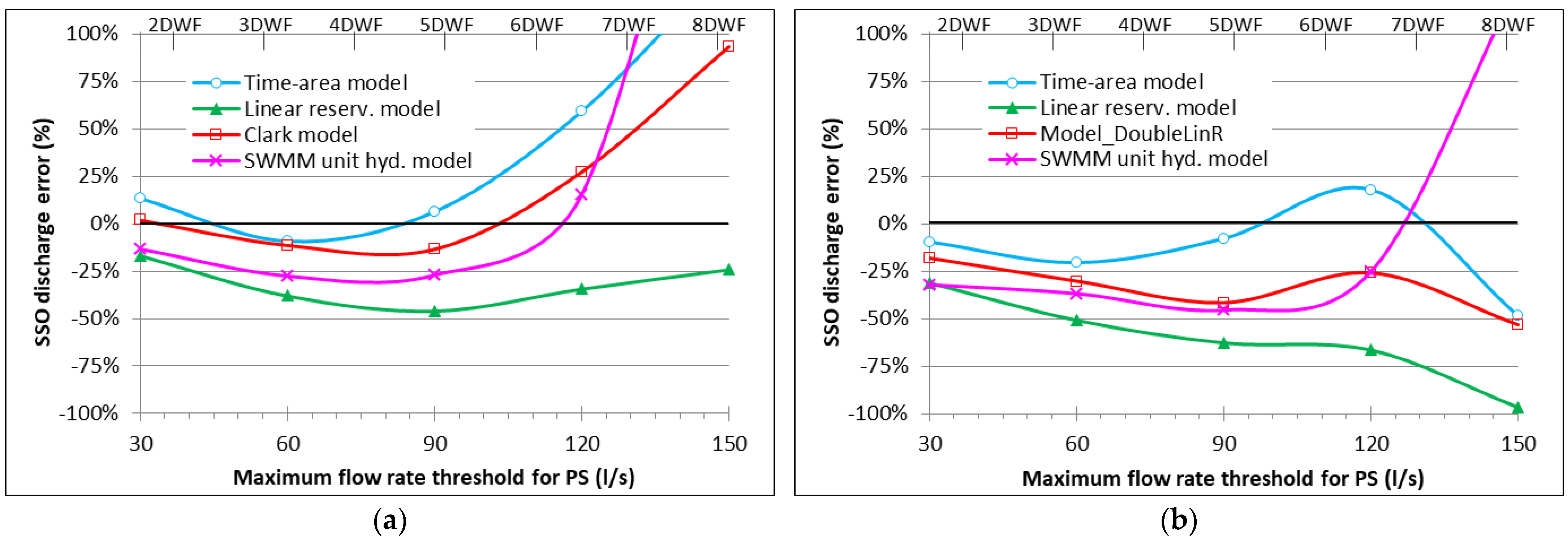
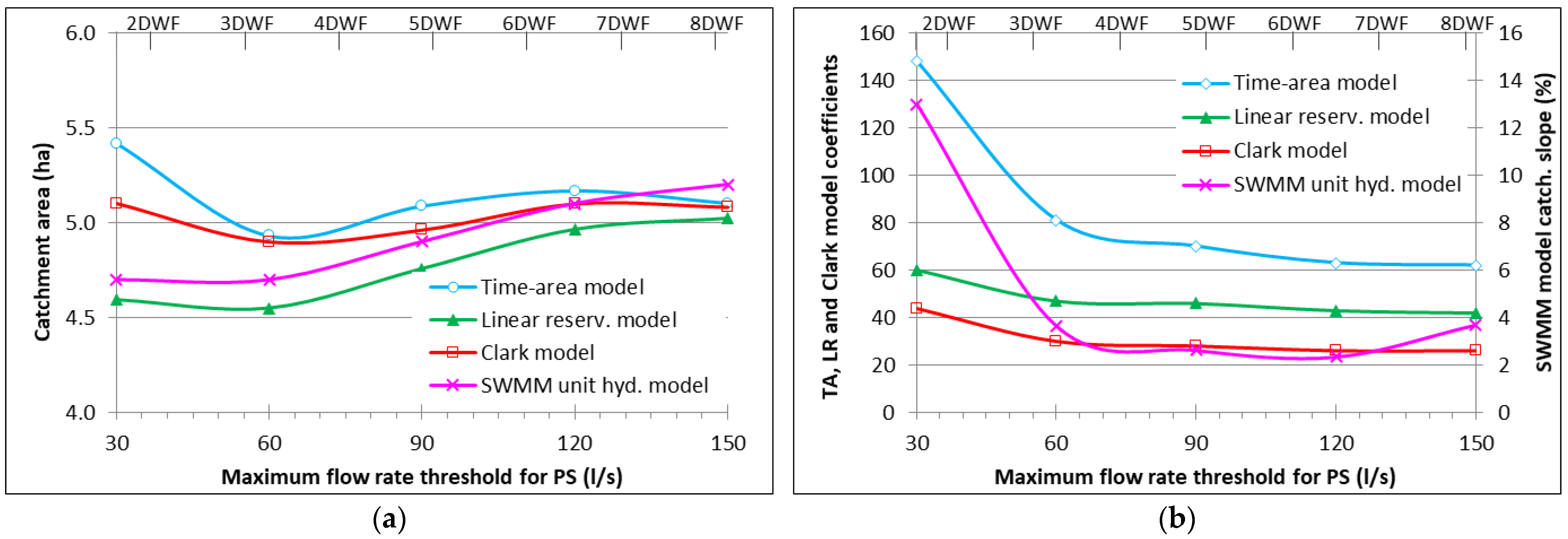
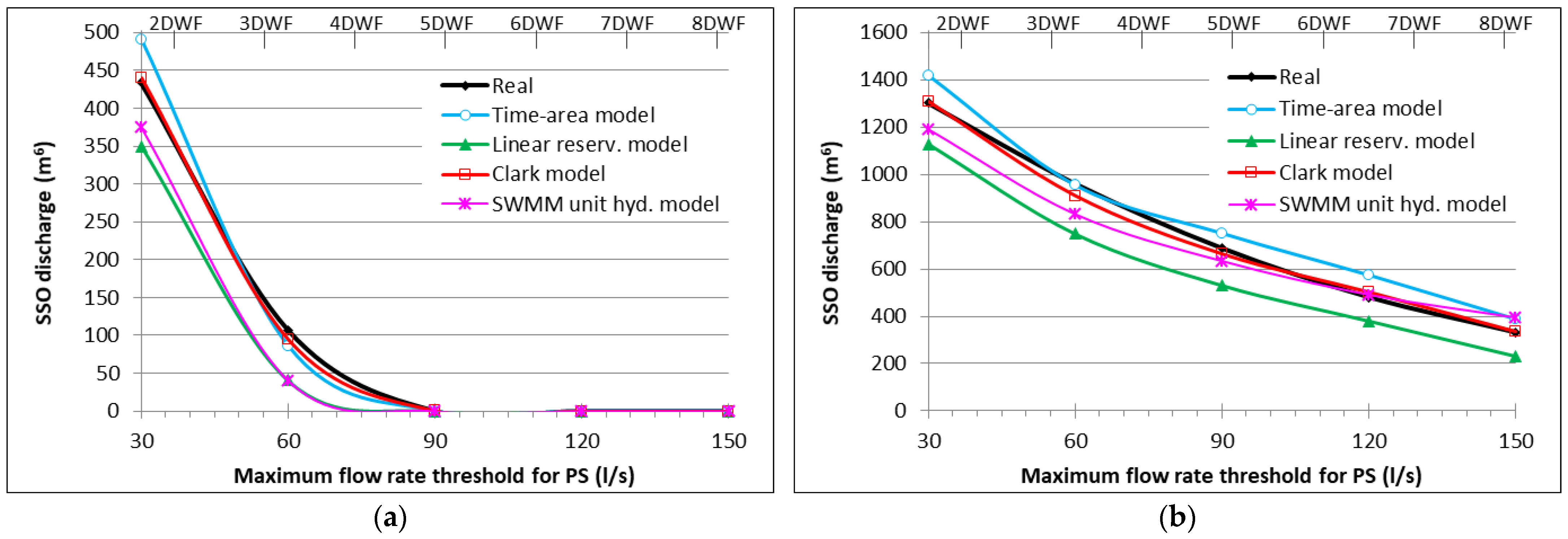
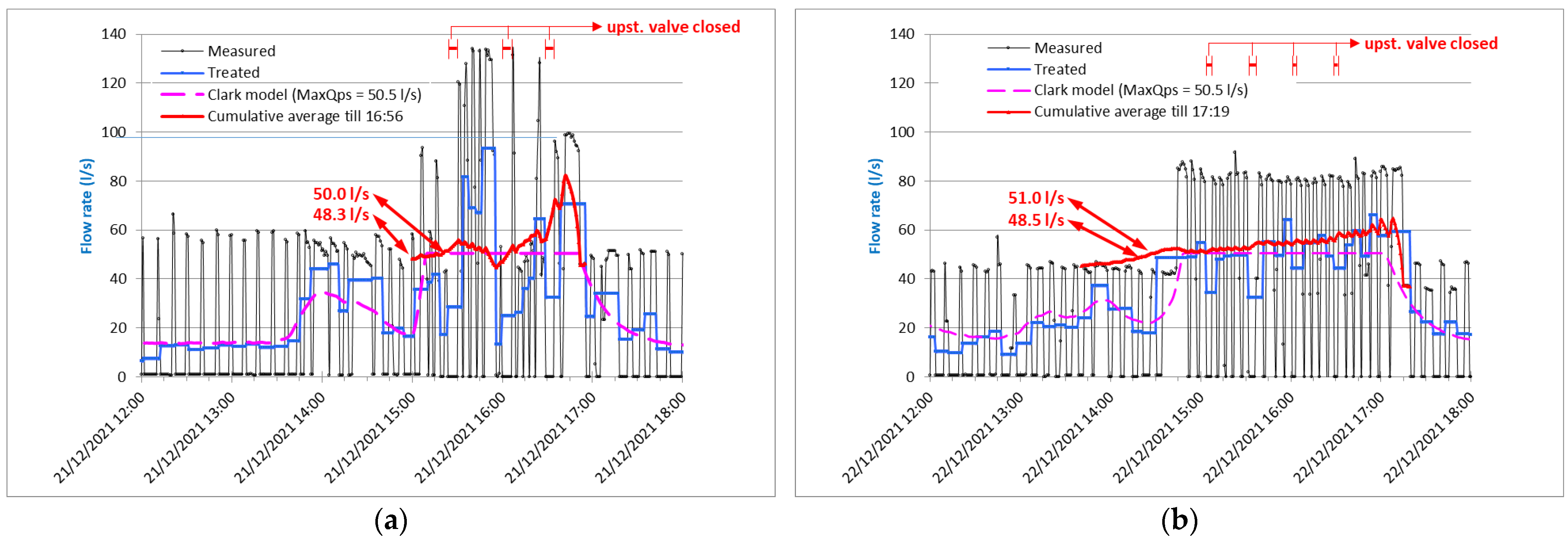
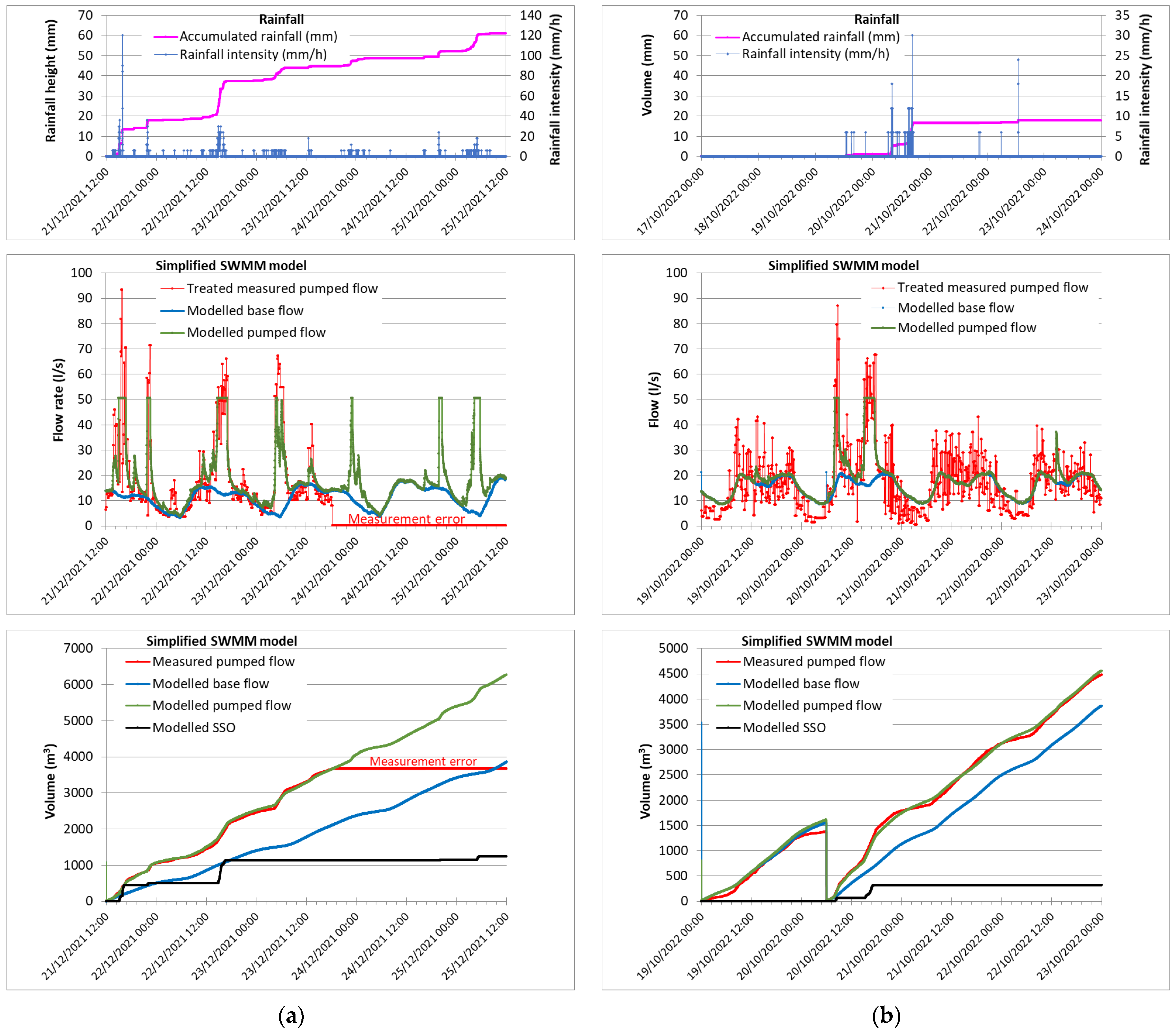
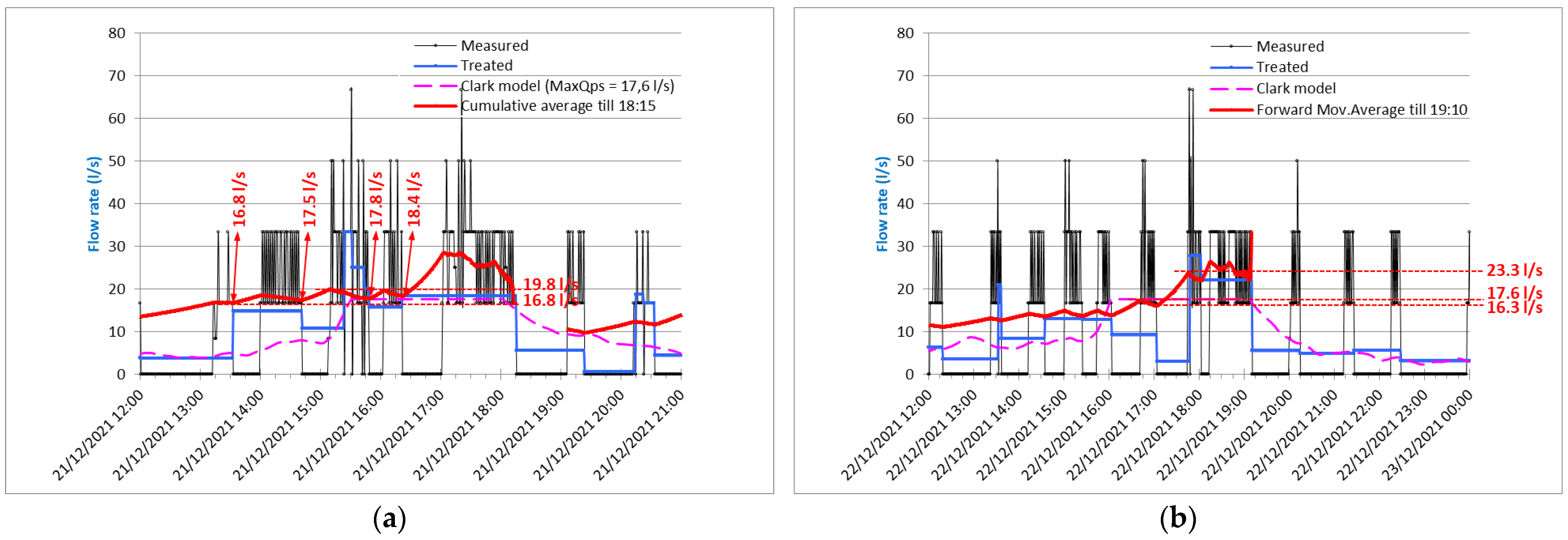
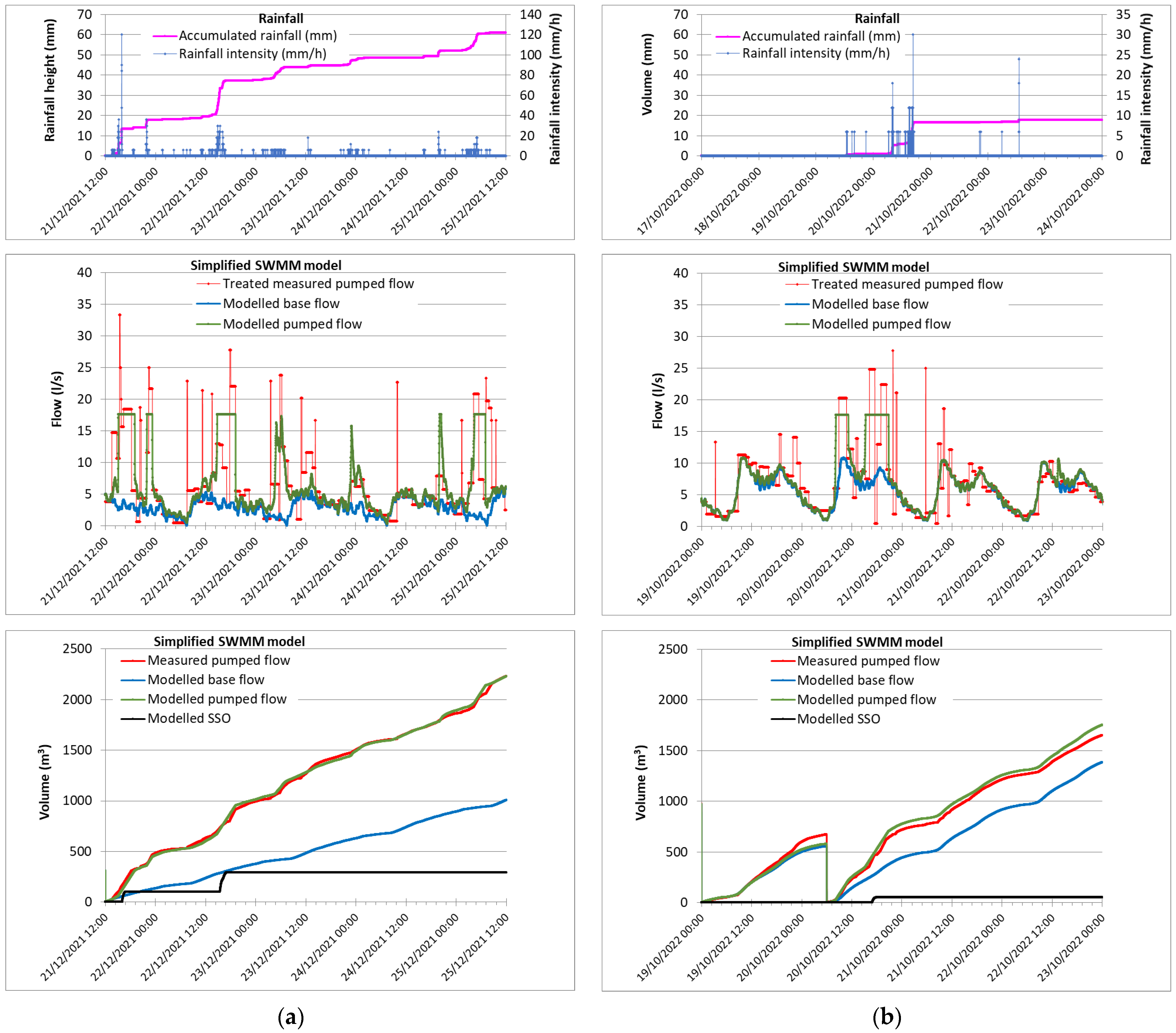

| Model | MaxQPS (L/s) | Area (ha) | Model Coefficient | Σ(E2) 1 (m6) | Pumped Stormw. (m3) | SSO Vol. (m3) |
|---|---|---|---|---|---|---|
| Time–area curve | 50.5 | 6.257 | t = 60 min. | 239,043 | 1543 | 1247 |
| Linear reservoir | 50.5 | 5.855 | K = 27 min. | 265,480 | 1543 | 1030 |
| Clark | 50.5 | 6.123 | t = K = 20 min. | 245,851 | 1543 | 1187 |
| Simplified SWMM | 50.5 | 6.000 | i = 0.774% | 279,988 | 1543 | 1130 |
Disclaimer/Publisher’s Note: The statements, opinions and data contained in all publications are solely those of the individual author(s) and contributor(s) and not of MDPI and/or the editor(s). MDPI and/or the editor(s) disclaim responsibility for any injury to people or property resulting from any ideas, methods, instructions or products referred to in the content. |
© 2024 by the authors. Licensee MDPI, Basel, Switzerland. This article is an open access article distributed under the terms and conditions of the Creative Commons Attribution (CC BY) license (https://creativecommons.org/licenses/by/4.0/).
Share and Cite
David, L.M.; Martins, A.; Rodrigues, M.; Oliveira, A.; Fortunato, A.B.; Silva, O.; Ataíde, A.; Mendes, A. Sanitary Sewer Overflow Discharges: Estimation Based on Flow Rate Measurement in Pumping Mains. Water 2024, 16, 1916. https://doi.org/10.3390/w16131916
David LM, Martins A, Rodrigues M, Oliveira A, Fortunato AB, Silva O, Ataíde A, Mendes A. Sanitary Sewer Overflow Discharges: Estimation Based on Flow Rate Measurement in Pumping Mains. Water. 2024; 16(13):1916. https://doi.org/10.3390/w16131916
Chicago/Turabian StyleDavid, Luís Mesquita, António Martins, Marta Rodrigues, Anabela Oliveira, André B. Fortunato, Osvaldo Silva, Alexandre Ataíde, and Ana Mendes. 2024. "Sanitary Sewer Overflow Discharges: Estimation Based on Flow Rate Measurement in Pumping Mains" Water 16, no. 13: 1916. https://doi.org/10.3390/w16131916
APA StyleDavid, L. M., Martins, A., Rodrigues, M., Oliveira, A., Fortunato, A. B., Silva, O., Ataíde, A., & Mendes, A. (2024). Sanitary Sewer Overflow Discharges: Estimation Based on Flow Rate Measurement in Pumping Mains. Water, 16(13), 1916. https://doi.org/10.3390/w16131916









